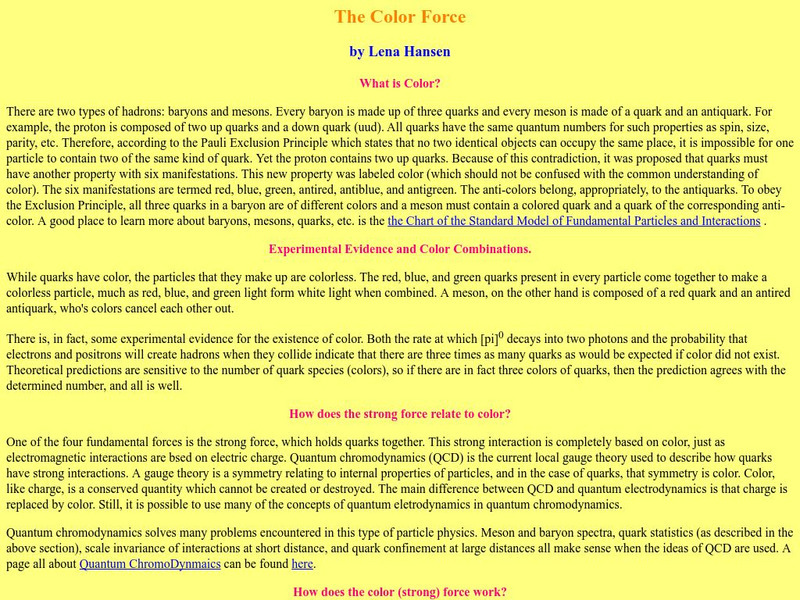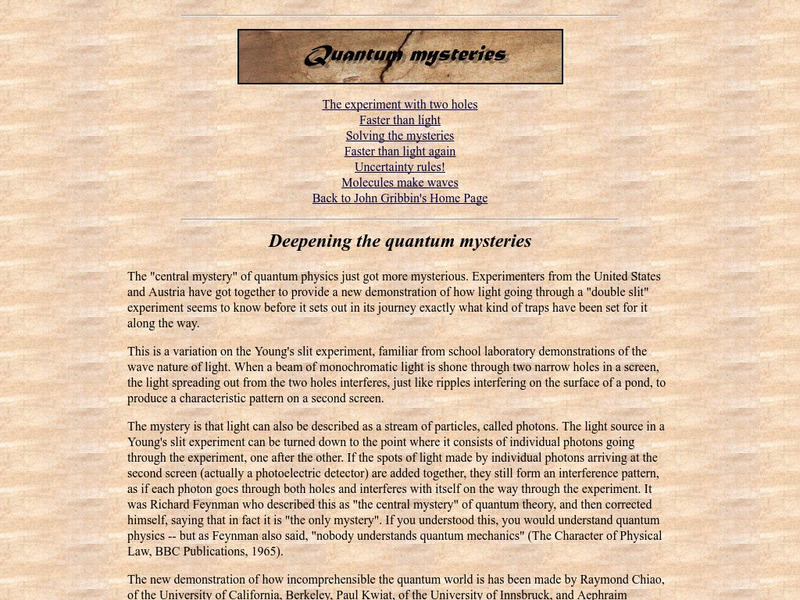Symmetry Magazine
Symmetry Magazine: Explain It in 60 Seconds: Acceleration of Particles
The process of particle acceleration is described. "Explain It In 60 Seconds" is an article series that aims to summarize in a few paragraphs the meaning of different concepts in particle physics.
Symmetry Magazine
Symmetry Magazine: Explain It in 60 Seconds: Simulations
Simulations are useful research tools for scientists and save a lot of time and money. Some of the ways they are used are described in this article. "Explain It In 60 Seconds" is an article series that aims to summarize in a few...
Symmetry Magazine
Symmetry Magazine: Explain It in 60 Seconds: Dark Matter
Dark matter is still quite a mystery to scientists, who hope to learn more about it through experiments with particle accelerators. "Explain It In 60 Seconds" is an article series that aims to summarize in a few paragraphs the meaning of...
Symmetry Magazine
Symmetry Magazine: Explain It in 60 Seconds: A Positron
Learn about positrons, an antiparticle and the opposite of an electron. Also available as a PDF, which requires Adobe Reader.
Symmetry Magazine
Symmetry Magazine: Explain It in 60 Seconds: Particle Event
Particle events, described in this article, are events that can be observed with a particle detector. "Explain It In 60 Seconds" is an article series that aims to summarize in a few paragraphs the meaning of different concepts in...
Symmetry Magazine
Symmetry Magazine: Explain It in 60 Seconds: Jets
Jets, described in this article, are particle sprays resulting from other particles colliding at high speeds, such as can happen in particle accelerators. "Explain It In 60 Seconds" is an article series that aims to summarize in a few...
Symmetry Magazine
Symmetry Magazine: Explain It in 60 Seconds: The Terascale
The terascale, described in this article, is a subatomic region that requires enormous amounts of energy in order to reach it. Scientists hope to be able to study it with the Large Hadron Collider. "Explain It In 60 Seconds" is an...
Symmetry Magazine
Symmetry Magazine: Explain It in 60 Seconds: W Boson
The W boson, described here, is important in the study of the differences between matter and antimatter. "Explain It In 60 Seconds" is an article series that aims to summarize in a few paragraphs the meaning of different concepts in...
Symmetry Magazine
Symmetry Magazine: Explain It in 60 Seconds: Rare Particle Decays
Rare particle decays, described here, are events that could lead to insights into the unknown processes of the universe. Scientists hope to learn more about them through research with particle accelerators. "Explain It In 60 Seconds" is...
Symmetry Magazine
Symmetry Magazine: Explain It in 60 Seconds: Z Boson
The Z boson, described here, is important in the study of electroweak force. "Explain It In 60 Seconds" is an article series that aims to summarize in a few paragraphs the meaning of different concepts in particle physics.
Symmetry Magazine
Symmetry Magazine: Explain It in 60 Seconds: Neutrino Masses
Neutrinos, described here, are particles scientists still have a lot to learn about. They are trying to measure their masses. "Explain It In 60 Seconds" is an article series that aims to summarize in a few paragraphs the meaning of...
Symmetry Magazine
Symmetry Magazine: Explain It in 60 Seconds: Magnet Quench
A magnet quench, explained here, is a routine event that happens within a particle accelerator that can require the accelerator to be shut down for a period of repair, losing valuable research time. "Explain It In 60 Seconds" is an...
Symmetry Magazine
Symmetry Magazine: Explain It in 60 Seconds: Particle Accelerators
Particle accelerators and what how they are used in research are explained briefly but succinctly here. "Explain It In 60 Seconds" is an article series that aims to summarize in a few paragraphs the meaning of different concepts in...
Symmetry Magazine
Symmetry Magazine: Explain It in 60 Seconds: Charm Quark
Charm quarks, described in this article, are a type of quark that is basic to matter. A particle with a charm quark deteriorates quickly into a regular particle. A study of these quarks could reveal critical information about matter....
Symmetry Magazine
Symmetry Magazine: Explain It in 60 Seconds: Virtual Particles
Virtual particles, described here, are particles that appear and disappear so rapidly they can be detected only by their effect on other particles. "Explain It In 60 Seconds" is an article series that aims to summarize in a few...
Symmetry Magazine
Symmetry Magazine: Explain It in 60 Seconds: Cherenkov Light
Cherenkov light is explained here as the light emitted when a charged particle travels through matter faster than light would be able to. This would be slower, however, than the maximum speed of light, which occurs in a vacuum. "Explain...
Duke University
Duke University: The Color Force
What does color have to do with particle physics? This page explains the concepts of color and the color force, which are fundamental subjects in quantum chromodynamics.
PBS
Science Odyssey: Heisenberg States Uncertainty Principle
Explains the Heisenberg Uncertainty Principle, that it is impossible to know both the momentum and position of an electron, along with describing the impact that it made upon the scientific community upon its introduction in 1927.
PBS
Nova: The Elegant Universe: Viewpoints on String Theory: Sheldon Glashow
Transcript of an interview with physicist Sheldon Glashow on his attitude toward string theory and its impact on the study of particle physics and cosmology.
Lawrence Berkeley National Laboratory
Berkeley Lab: The Particle Adventure: Leptons
This particle physics tutorial discusses the different types of leptons: the electron, tau lepton, muon lepton, and neutrinos.
Other
Cern: The Delphi Experiment
This is the home page of the DELPHI experiment at CERN. It provides links to various parts of the experiment and explains the operation of the detector. The general operation is explained at a basic level, but the physics is much more...
Other
Quantum Mysteries: Deepening Quantum Mysteries
Although it is arguably the most successful theory in physics, quantum physics has often baffled and confounded both its practitioners and the general public. This informative website discusses the types of mysteries, which still plague...
Lawrence Berkeley National Laboratory
Berkeley Lab: La Aventura De Las Particulas
Learn the fundamentals of particles and forces with this site. Explore the paths that explain matter in the universe.
Thomas Jefferson National Accelerator Facility
Jefferson Lab: Coloring Book: Quarks More Than Meets the Eye
Understand and appreciate the research conducted at Jefferson Lab about the smallest particle, the quark.









